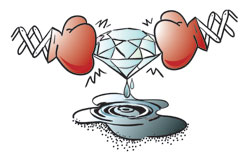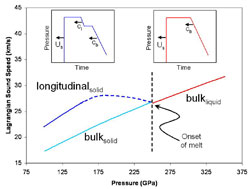NEWS RELEASES
FOR IMMEDIATE RELEASE
November 2, 2006
Z machine melts diamond to puddle
As capsule for nuclear-fusion fuel, even diamonds aren’t forever
 (Illustration by Michael Vittitow)
(Illustration by Michael Vittitow) Download 300dpi JPEG image, “diamond-pressure.jpg,” 836K (Media are welcome to download/publish this image with related news stories.)
ALBUQUERQUE, N.M. — Sandia’s Z machine, by creating pressures more than 10 million times that of the atmosphere at sea level, has turned a diamond sheet into a pool of liquid.
The object of the experiment was to better understand the characteristics of diamond under the extreme pressure it would face when used as a capsule for a BB- sized pellet intended to fuel a nuclear fusion reaction.
The experiment is another step in the drive to release enough energy from fused atoms to create unlimited electrical power for humanity. Control of this process has been sought for 50 years.
Half a bathtub full of seawater in a fusion reaction could produce as much energy as 40 train cars of coal.
Results of the fusion reaction also will be used to validate physics models in computer simulations used to certify the safety and reliability of the US nuclear weapons stockpile.
Sandia is a National Nuclear Security Administration facility.
The problem for two giant machines that would use this method — the National Ignition Facility in Lawrence Livermore National Lab, which asked for the experiment, and Sandia’s Z machine — is that the outer shell of the pellet must transmit pressure evenly into its interior. Diamond as a solid will do that. Diamond as a liquid will do that. But diamond that is partially both and exists between 6.9 million atmospheres and 10.4 million atmospheres provides uneven pressures. This in-between phase would create instabilities that would ruin the implosion, like a hand squeezing a water balloon that allows portions of the balloon to exit through spaces between the fingers.
 Conceptual plot of sound speed as a function of pressure.
In the experiment, a steady shock is produced, followed by a
rapid release in pressure. The character of the release wave
following the shock front is highly dependent on whether the
shocked state is a solid or liquid. A solid material has the
ability to resist deformation, a property referred to as strength.
Due to the strength of the material, the release wave breaks
up into a two-wave structure, as shown in the upper left hand
inset. The initial release travels at the longitudinal sound
speed, cl, and the subsequent release travels at the bulk sound
speed, cb, with cl>cb. As the material approaches melt, the strength
decreases and the difference in cl and cb becomes smaller. For
a strong enough shock, the material will begin to melt. At this
point the shocked material loses all strength and will only
support a single release wave traveling at the bulk sound speed,
as shown in the upper right hand inset.
Conceptual plot of sound speed as a function of pressure.
In the experiment, a steady shock is produced, followed by a
rapid release in pressure. The character of the release wave
following the shock front is highly dependent on whether the
shocked state is a solid or liquid. A solid material has the
ability to resist deformation, a property referred to as strength.
Due to the strength of the material, the release wave breaks
up into a two-wave structure, as shown in the upper left hand
inset. The initial release travels at the longitudinal sound
speed, cl, and the subsequent release travels at the bulk sound
speed, cb, with cl>cb. As the material approaches melt, the strength
decreases and the difference in cl and cb becomes smaller. For
a strong enough shock, the material will begin to melt. At this
point the shocked material loses all strength and will only
support a single release wave traveling at the bulk sound speed,
as shown in the upper right hand inset.Download 300dpi JPEG image, “diamonds-melt2.jpg,” 200K (Media are welcome to download/publish this image with related news stories.)
So, if diamond is used as a capsule, the energies involved must be tailored to avoid landing in this zone.
Why use diamond at all? It was hoped that diamond would help smooth out the applied pressure loads and keep the capsule implosion symmetric.
Wouldn’t a more flexible material like vinyl be better?
“At the pressures we’re interested in, everything is compressible,” said capsule designer Mark Herrmann, a Sandia researcher.
Because of limited time to run the experiments, due to the shutdown of Z for renovations that should increase its power by 30 percent, Sandia lead experimenter Marcus Knudson found a predictive use of a quantum-molecular simulation program developed at Sandia by Mike Desjarlais very helpful in pinpointing the pressures at which diamond would begin and finish liquefying.
In the experiments, the applied pressure came from shock waves passing through the diamond. The waves were created by impacting the diamond with tiny plates hurled using Z’s huge magnetic fields at about 20 times the speed of a rifle bullet.
The results were the subject of an invited talk given this week at the American Physical Society’s Division of Plasma Physics in Philadelphia.
Sandia is a multiprogram laboratory operated by Sandia Corporation, a Lockheed Martin company, for the U.S. Department of Energy’s National Nuclear Security Administration. Sandia has major R&D responsibilities in national security, energy and environmental technologies, and economic competitiveness.
Sandia news media contact: Neal Singer, nsinger@sandia.gov, (505) 845-7078